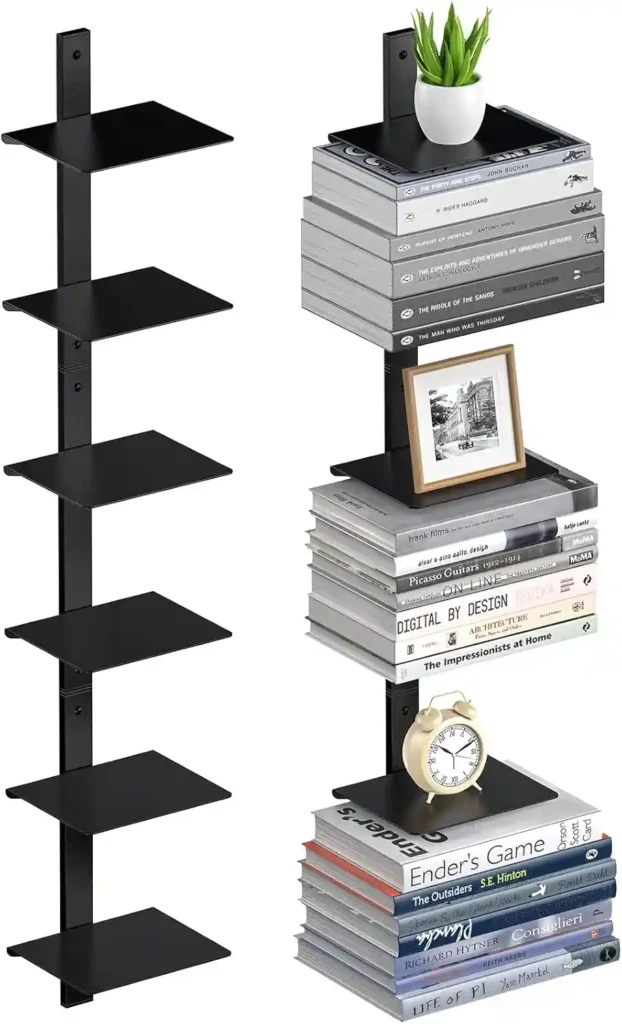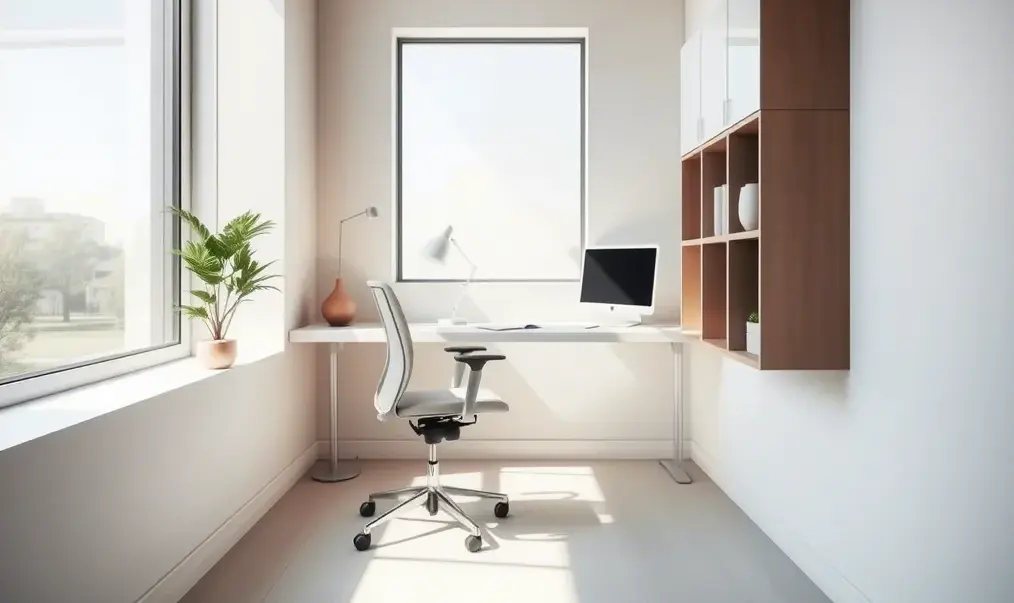In an era where remote work has become increasingly prevalent, creating an efficient and aesthetically pleasing home office isn’t just a luxury—it’s a necessity.
Whether you’re working with a dedicated room or carving out a corner of your living space, minimalist small office design offer the perfect solution for small office spaces.
The art of doing more with less has never been more relevant, especially when it comes to crafting productive workspaces that don’t overwhelm your home’s footprint.
Contents
- What is minimalist small office design?
- 1. Choose a Neutral Color Palette
- 2. Opt for Multi-Functional Furniture
- 3. Declutter and Organize
- 4. Use Vertical Space
- 5. Incorporate Natural Light
- 6. Keep Decor Simple and Functional
- 7. Invest in Ergonomic Furniture
- 8. Embrace Open Layouts
- 9. Use Mirrors to Create Illusion of Space
- 10. Stick to a Minimalist Tech Setup
- FAQs About Minimalist Small Office Design
What is minimalist small office design?
At its core, minimalist office design is an approach that strips away the unnecessary while elevating the essential.
Think of it as Marie Kondo meets modern workplace design—where every element serves a purpose, and beauty emerges from simplicity rather than abundance.
This design philosophy isn’t just about aesthetic appeal; it’s a practical solution that transforms cramped quarters into focused, productive environments.
The beauty of minimalist design lies in its versatility. In small offices, this approach works wonders by creating the illusion of space while maintaining full functionality. When every square inch counts, minimalism isn’t just an aesthetic choice—it’s a strategic one.
By eliminating visual noise and physical clutter, you’re not just creating a more spacious-feeling environment; you’re crafting a workspace that promotes mental clarity and enhanced productivity.
Research from the Princeton University Neuroscience Institute has shown that cluttered environments significantly impact our ability to focus and process information.
A minimalist office design directly addresses this by reducing visual distractions and creating a space that allows your brain to focus on what truly matters: your work.
1. Choose a Neutral Color Palette
The foundation of any minimalist office design starts with color—or rather, the thoughtful absence of too much color. A neutral palette serves as the canvas upon which you’ll build your productive space, with each shade carefully selected to create an atmosphere of calm focus.
White, in its various incarnations, remains the cornerstone of minimalist design. From crisp Arctic white to softer ivory tones, these shades reflect light and make spaces feel more expansive. Warm greys and soft beiges offer alternatives that maintain the minimalist aesthetic while adding depth and warmth to your office environment.
That said, embracing neutrals doesn’t mean condemning yourself to a sterile, hospital-like environment. The key lies in layering different shades and textures within your chosen neutral palette. Consider incorporating:
- A main wall in pure white to maximize light reflection
- An accent wall in warm grey to add depth without overwhelming the space
- Natural wood tones through furniture pieces to bring organic warmth
- Subtle metallic accents in silver or brushed gold to add sophistication
2. Opt for Multi-Functional Furniture
In the world of small office design, furniture that serves multiple purposes isn’t just clever—it’s essential. Today’s market offers an impressive array of innovative solutions that combine form and function in increasingly ingenious ways. A desk that folds away when not in use, or a filing cabinet that doubles as a printer stand, can be worth its weight in gold when space is at a premium.
Consider these space-saving champions:
The wall-mounted desk with built-in storage compartments serves as both a workspace and minimalist office organization system. When paired with a comfortable yet compact chair that slides completely underneath, you’ve got a full workstation that can practically disappear when needed.
Storage ottomans offer a perfect example of functional fusion—providing both additional seating for clients or colleagues and a place to store rarely-used supplies. Some even flip over to become impromptu laptop stands, proving that with clever design, limitations often spark innovation.
3. Declutter and Organize
The soul of minimalist design lies in its commitment to essentials. In a small office, this principle becomes even more crucial. Start by conducting a ruthless audit of your space—every item should earn its place through regular use or absolute necessity.
Implementing the “one in, one out” rule helps maintain the minimalist integrity of your space. Before introducing any new item to your office, identify something that can be removed. This creates a natural balance and prevents the gradual accumulation of unnecessary items that can quickly overwhelm a small space.
Smart storage solutions play a pivotal role in maintaining order:
- Floating shelves installed at varying heights create visual interest while maximizing vertical storage
- Cable management systems that hide technological clutter beneath or behind your desk
- Drawer organizers with adjustable compartments that adapt to your changing needs
- Digital storage solutions that eliminate the need for physical document storage
4. Use Vertical Space
When floor space comes at a premium, the walls become your best allies. Vertical space utilization is perhaps one of the most underappreciated aspects of small office design, yet it holds immense potential for both storage and style.

Modern wall-mounted systems offer unprecedented flexibility. Track-based systems, for instance, allow you to adjust shelf heights and configurations as your needs change. Some innovative solutions include:
- Modular wall panels that accommodate everything from file holders to small plants
- Floating desks that can be installed at any height, perfect for creating standing work options
- Magnetic boards that double as artwork when not covered in important notes
- Vertical file organizers that transform paperwork into a design element
Remember to maintain visual balance when utilizing vertical space. While it’s tempting to fill every available inch, leaving some walls bare helps maintain the minimalist aesthetic and prevents the space from feeling cluttered or overwhelming.
5. Incorporate Natural Light
Natural light is the unsung hero of minimalist office design, capable of transforming even the smallest space into an airy, welcoming environment. Beyond its aesthetic benefits, natural light has been proven to boost productivity, improve mood, and reduce eye strain—making it an essential element of any well-designed workspace.
To maximize natural light in your office:
Position your desk perpendicular to windows rather than directly facing them to reduce glare while still benefiting from natural illumination. Use light, translucent window treatments that filter harsh sunlight without blocking it entirely. Consider installing a small mirror opposite your window to bounce light deeper into the room.
When natural light is limited, supplement with carefully chosen artificial lighting. Layer your lighting with:
- Task lighting for focused work
- Ambient lighting to eliminate harsh shadows
- Accent lighting to highlight architectural features or artwork
6. Keep Decor Simple and Functional
In minimalist design, every decorative element should serve a purpose beyond mere aesthetics. This doesn’t mean your office should feel sterile or impersonal—rather, it’s about choosing decor that enhances both the form and function of your space.
A single, well-chosen plant can improve air quality while adding life to your workspace. A sleek clock keeps you on schedule while serving as wall art. A carefully selected piece of abstract art can inspire creativity without overwhelming the space.
The key is to be intentional with your choices. Consider these guidelines:
- Limit yourself to one or two decorative items per surface
- Choose items that complement your neutral color palette
- Opt for decor that serves multiple purposes
- Rotate seasonal or inspirational pieces rather than displaying everything at once
7. Invest in Ergonomic Furniture
A minimalist office doesn’t mean sacrificing comfort. In fact, investing in quality ergonomic furniture often results in needing fewer pieces overall, as each item is designed to support optimal productivity and well-being.
When selecting ergonomic furniture for a small office, focus on:
- Chairs with adjustable height, lumbar support, and armrests that fit neatly under your desk
- Desk surfaces that can be adjusted for both sitting and standing work
- Monitor arms that free up desk space while maintaining proper screen height
- Keyboard trays that promote proper wrist positioning without requiring additional surface area
Remember that the best ergonomic solution is one that encourages movement throughout the day. Consider incorporating a small balance board or under-desk elliptical that can be stored away when not in use.
8. Embrace Open Layouts
The power of negative space cannot be overstated in minimalist design. An open layout creates breathing room for both your body and mind, making even the smallest office feel more spacious and inviting.
To create and maintain an open layout:
- Keep primary pathways clear and direct
- Create distinct zones for different activities without using physical barriers
- Position furniture to promote flow and movement
- Maintain clear sightlines across the space
Consider the principle of “ma”—the Japanese concept of negative space. This philosophy suggests that empty space is not truly empty but rather full of possibility and potential. In your office, these open areas provide room for movement, thought, and creativity.
9. Use Mirrors to Create Illusion of Space
Mirrors are more than just decorative elements in a minimalist office—they’re powerful tools for space optimization. When strategically placed, mirrors can double the perceived size of your workspace while amplifying natural light and creating interesting visual perspectives.
For maximum impact:
- Position a large mirror opposite your window to reflect natural light
- Use mirrored cabinet doors to combine storage with space-enhancing properties
- Install a full-length mirror behind your desk to create the illusion of depth
- Consider mirrored accent pieces that serve multiple purposes
The key is to use mirrors thoughtfully rather than abundantly. One well-placed mirror can have more impact than several smaller ones scattered throughout the space.
10. Stick to a Minimalist Tech Setup
In today’s digital age, technology is often the biggest challenge to maintaining a minimalist office. However, with thoughtful planning and the right solutions, you can create a tech-friendly space that doesn’t feel overwhelmed by gadgets and wires.
Consider these strategies:
- Opt for wireless peripherals whenever possible
- Use a laptop stand that doubles as a cooling pad
- Implement a charging station that keeps devices organized and wires hidden
- Choose monitors with built-in speakers to eliminate the need for external ones
Cable management becomes crucial in a minimalist setup. Invest in:
- Under-desk cable trays
- Adhesive cable clips
- Wireless charging solutions
- Cable sleeves in colors that match your walls
FAQs About Minimalist Small Office Design
What colors are best for a minimalist small office design?
The most effective colors for a minimalist office are typically whites, greys, and natural tones. White reflects light and creates an illusion of space, while warm greys add depth without overwhelming the room. Natural wood tones can add warmth and character while maintaining the minimalist aesthetic.
How can I make a minimalist small office design look bigger?
Several techniques can help maximize the perceived size of your office:
- Use light colors on walls and furniture
- Maximize natural light
- Implement vertical storage solutions
- Keep floors clear and pathways open
- Use multi-functional furniture
- Install mirrors strategically
- Maintain a clutter-free environment
What furniture is best for a minimalist small office design?
The best furniture for a minimalist office combines functionality with clean lines and space-saving design. Look for:
- Wall-mounted or floating desks
- Chairs that tuck completely under desks
- Storage solutions with hidden compartments
- Furniture with built-in cable management
- Pieces that serve multiple purposes
How do I maintain a minimalist small office design over time?
Maintaining a minimalist office requires ongoing attention and regular habits:
- Implement a daily cleanup routine
- Digitize documents whenever possible
- Practice the “one in, one out” rule
- Regularly assess and purge unnecessary items
- Create designated spaces for everything
- Address clutter immediately rather than letting it accumulate
Remember, minimalism is not just about aesthetics—it’s a practical approach to creating a more productive and enjoyable workspace. By following these principles and regularly reassessing your needs, you can maintain an office that supports both your work and your well-being.


